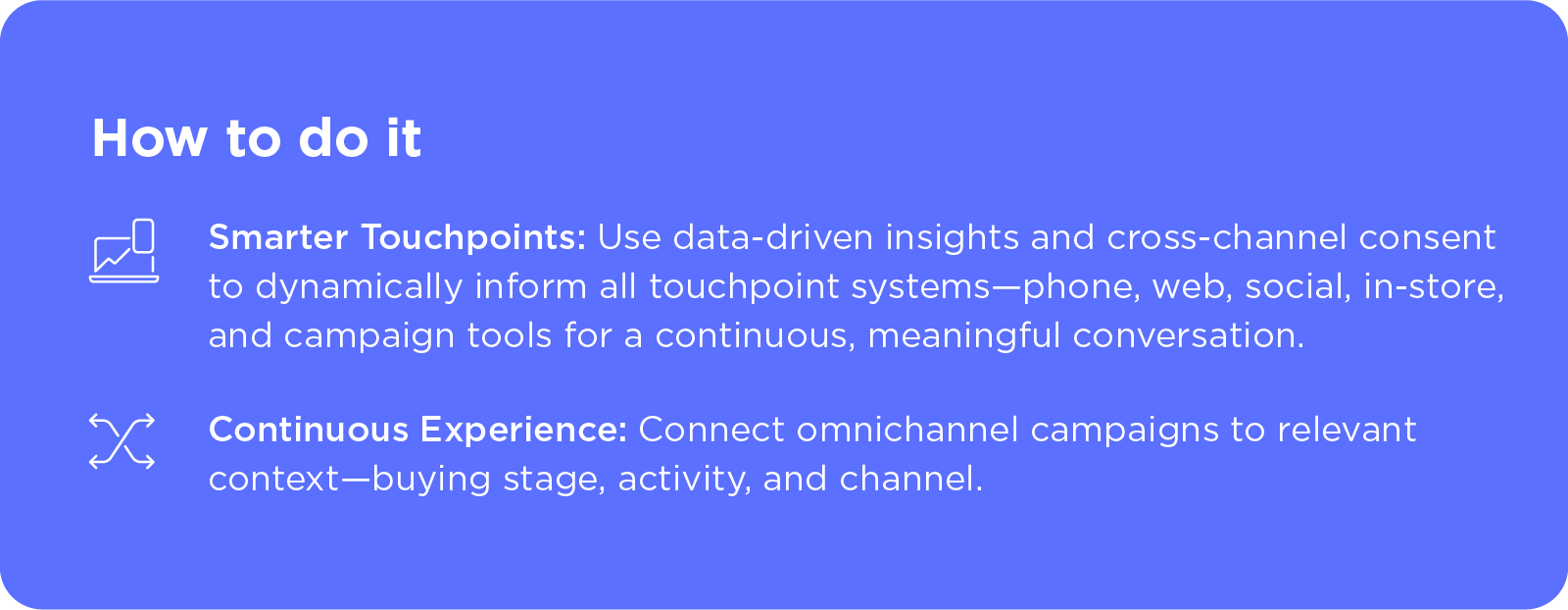Mapping the Customer Decision Journey To Improve Your Marketing
Last updated February 2, 2023
The world has changed dramatically since 2006, when Clive Humby first coined the phrase: “Data is the new oil.” And while a trusted customer data foundation remains the backbone of an effective marketing strategy, we would argue that customer experience might be the new “new oil.” In fact, with brand loyalty on the decline, customer experience is what can make or break a relationship with a brand. So how do you keep up with the ever-evolving demands of your customers and meet their needs across various channels?With an omnichannel approach becoming the norm, connected customer experiences are essential for acquiring and keeping customers. In addition, your customers’ interaction with your brand is not a one-time event, but an ongoing journey with multiple touchpoints. This customer decision journey is the path that an individual customer takes when deciding to buy a product or service. By understanding the customer decision journey—and using it to inform your marketing strategy—you can create more meaningful connections (and meaningful experiences) with your customers and increase return on your marketing investment.Still, many brands struggle due to a lack of understanding about what the customer expects from their purchase journey. Do you know how your customers interact with your products and services at each stage of their decision-making process? Do you know the best type of content that will resonate? This is where mapping your customer decision journey comes in. Mapping helps you to identify areas where you can improve the customer experience, increase conversions, and reduce costs. It also allows you to identify any potential issues that could prevent customers from making a purchase or using your services again in the future.Here are three key steps to mapping out a successful customer decision journey:
1. Put Yourself in the Customer’s Shoes
The first step to mapping the customer journey is to put yourself in their shoes. Try to think of all potential touchpoints throughout their entire experience—from first impressions to purchase decisions—and imagine what questions they are asking or what problems they may be facing at each stage. Are there specific customer pain points or areas for improvement, such as website navigation or product packaging? By understanding your customers’ needs and motivations, you can then create more effective marketing strategies that target those customers more effectively. Furthermore, when you create relevant content that resonates with your audience, you build trust among existing customers while increasing engagement levels with prospective ones. The result: a better customer experience.

2. See Gaps in Your Interactions
Once you have a better understanding of how customers interact with your business, it’s time to start looking for gaps in those interactions. Do you have content available for each stage? Is there enough information about each product/service? Are support calls and emails answered quickly? By analyzing data around key performance indicators such as site visits, page views, time on page and conversions, you can begin to uncover patterns in customer behavior which will inform their strategy going forward.

3. Understand the Customer Journey in an Omnichannel World
Today’s omnichannel customer journey can comprise any number of touchpoints spread between mobile apps, social media platforms, websites, and physical stores. And data-driven customer insights can help marketers determine which touchpoints should be used in order to increase sales velocity. But by focusing on the journey as whole, rather than each individual channel, you can create a unified customer experience across all channels. This type of omnichannel customer experience means that your customer’s relationship with your company remains true across every department—online and offline. This leads to higher engagement levels, increased customer loyalty, and ultimately more revenue for the business.

Identifying patterns and trends in customer behavior is essential for transforming the customer experience. To that end, understanding—and optimizing—the customer decision journey can give you a competitive advantage. Through an omnichannel approach, you can track and analyze customer interactions across all channels to identify patterns that can inform marketing strategies such as segmentation, targeting, and personalization. You can target your most engaged customers with personalized offers and build enjoyable experiences that lead to repeat business. By creating the right type of content for each stage of the journey—and sharing it on the right channels—you’ll reach more customers and increase sales velocity.
Next Steps
Leveraging data to understand customer behavior is essential to creating a successful marketing strategy. Treasure Data Journey Orchestration offers a central, user-friendly location for bringing data and insights together in AI-powered customer profiles that connect teams and systems across internal business units and between various brands. Using a visual, drag-and-drop canvas, marketers can create, monitor, and optimize journeys that are unique to each customer as they go from brand awareness to purchase to brand loyalty and beyond.If you’re looking for actionable ways to elevate your customer journey and create a memorable, connected customer experience across all stages and channels, our new e-book “How to Create Memorable Connected Customer Experiences Across All Customer Journey Stages” is the perfect place to start. In this guide, we’ll show you exactly what building a connected customer experience looks like at every stage of the customer journey—and what tools you need to ensure you’re engaging customers when and where they want to be engaged.
